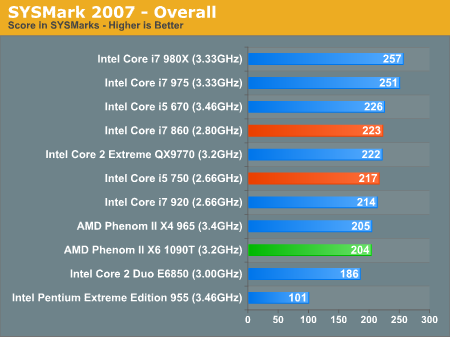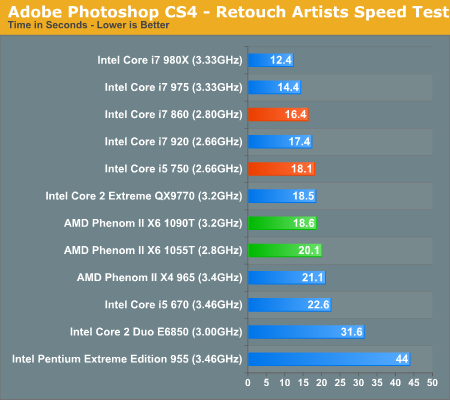AMD's Six-Core Phenom II X6 1090T & 1055T Reviewed
by Anand Lal Shimpi on April 27, 2010 12:26 AM EST- Posted in
- CPUs
- AMD
- Phenom II X6
SYSMark 2007 Performance
Our journey starts with SYSMark 2007, the only all-encompassing performance suite in our review today. The idea here is simple: one benchmark to indicate the overall performance of your machine.
SYSMark really taxes two cores most of the time, giving the edge to Lynnfield and its aggressive turbo modes. Lightly threaded or mixed workloads won't do so well on the Phenom II X6.

Adobe Photoshop CS4 Performance
To measure performance under Photoshop CS4 we turn to the Retouch Artists’ Speed Test. The test does basic photo editing; there are a couple of color space conversions, many layer creations, color curve adjustment, image and canvas size adjustment, unsharp mask, and finally a gaussian blur performed on the entire image.
The whole process is timed and thanks to the use of Intel's X25-M SSD as our test bed hard drive, performance is far more predictable than back when we used to test on mechanical disks.
Time is reported in seconds and the lower numbers mean better performance. The test is multithreaded and can hit all four cores in a quad-core machine.

Performance here is good, but even Photoshop doesn't make consistent enough use of all six cores to really give the Phenom II X6 the edge it needs here. It's faster than the Phenom II X4, but not faster than the Core i5 750.










168 Comments
View All Comments
Boogaloo - Tuesday, April 27, 2010 - link
That's pretty disappointing scaling from the 965 to the 1055T.. I'd be willing to bet the lack of added cache (not to mention the memory controller issues the article raises) are really holding back the performance. Unfortunately, 6 cores at 45nm hasn't left them with much of a choice as far as that goes.SonicIce - Tuesday, April 27, 2010 - link
looks like the 7z compression rate went down with turbo core enabled? an error?Ryan Smith - Tuesday, April 27, 2010 - link
Yeah, we accidentally flipped the chart. It has been fixed.FragKrag - Tuesday, April 27, 2010 - link
A bit underwhelming since before I read this bench, I saw overclock3d benches (they had 1090T at stock absolutely thrashing an i7 at 4GHz). Seems like the ideas that most of the people had with threading were true though. Overall I think they should be decently competitive because they do hold the advantage in cores.It's nice to see AMD pushing Intel a bit, though this does not make me regret my earlier purchase of the i7 860 as much as I would have liked it to.
Is there some kind of error with TurboCore? It doesn't look like it's working because those Dragon Age (optimized for quads?) and Dawn of War FPSs were a bit disappointing! :(
beginner99 - Tuesday, April 27, 2010 - link
Well as always for the last couple of years. This can't go on forever. Just if you think about the margins that intel has and the one that AMD has (if any...).The Problem I see is that in the cheaper price regions (=mainstream) users do not need a ton of cores. In the end most could easly live with 1 core even though 2 would probably lead to a "feelable" difference.
So I'm not sure if it's very intelligent to invest money in these designs. Just look at the die shot. I'm not an expert but you don't need to be to see that the just attached 2 more cores to an existing design probably having to make a ton of trade-off's (like the l3 cache).
I mean it is theoretically great. The easy upgrade path but again, how many users actually ever upgrade? IMHO a tiny fraction.
Of course thise i3/i5 dual cores from intel are overpriced. But that's what most company PC's will use. Huge profits for intel.
I hope at least AMD's answer to atom will be very good (=alot faster, same power consumption). But I doubt it...
ET - Tuesday, April 27, 2010 - link
The entry level crowd isn't the problem. Someone who only requires basic performance should buy the cheapest CPU, and AMD has that slot. For the performance crowd, Intel is the clear winner, but it's not the majority of the market. The real issue here is the price performance crowd, the people who want good performance for a good price. This is a pretty large market and AMD is trying to win here by reducing the price, but it's not doing great by this review.I think AMD still makes money on all CPU's, just not nearly as much as Intel.
Scali - Tuesday, April 27, 2010 - link
"Someone who only requires basic performance should buy the cheapest CPU, and AMD has that slot."I think that's his point though?
This CPU is not the 'cheapest'. Why invest in a design like this?
As Anand says in the conclusion, for 'mixed' usage, the i860 is a better choice. Only people who need heavily threaded performance may want this CPU. Especially at the pice at which AMD is selling these six-cores, can they really get a good return-on-investment on the development of this CPU?
Seems like dualcores and quadcores is where the bulk of the sales will be.
jamyryals - Tuesday, April 27, 2010 - link
Your argument is short-sighted. You can't stay with 4 core models indefinitely and expect to remain competitive in the future. R&D money has to be spent on the new technology even if your niche is the Price/performance budget sector.Scali - Tuesday, April 27, 2010 - link
I think it's short-sighted to just look at the number of cores.What AMD REALLY needs is a core architecture with a good IPC and relatively cheap to produce. That is what made the K7 and K8 so successful.
Currently AMD is just throwing more transistors at the problem, which is not a good thing, given their position (45 nm process vs Intel's 32 nm).
If anything Intel proves that it's not the number of cores, since Intel's quadcores generally outperform AMD's six-core. So as it stands today, Intel can stay with quadcores just fine.
beginner99 - Tuesday, April 27, 2010 - link
exactly my thought.But I must admit I did not think about servers at all. If it was easy to adopt a server cpu which had to be made anyway then it's a different story. (is it a half-magny-cours?)
But generally i would say a complete new architecture is needed soon to stay competitive.
Phenom architecture is quite old now and never was that good anyway especially compared to core architecture...